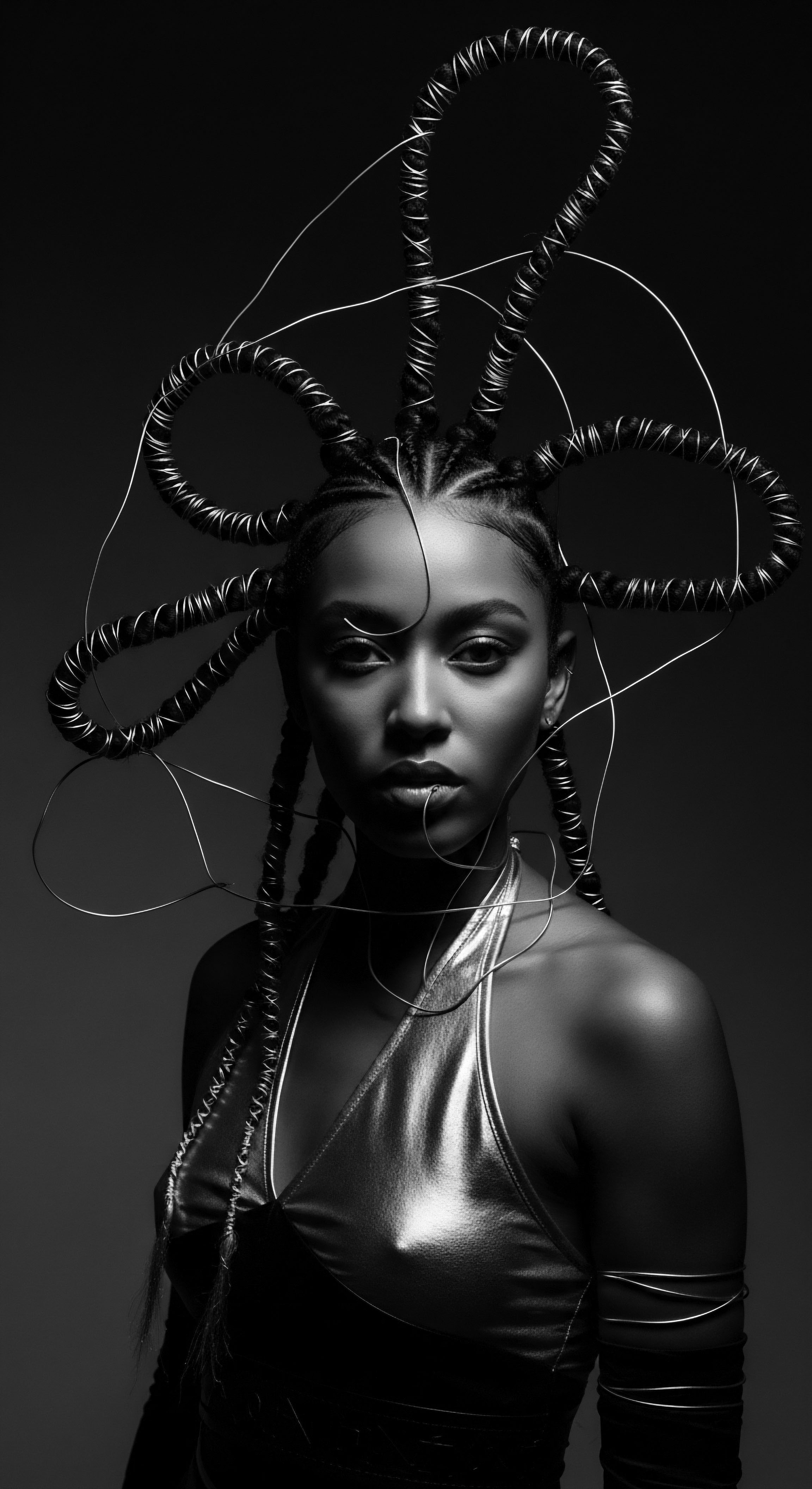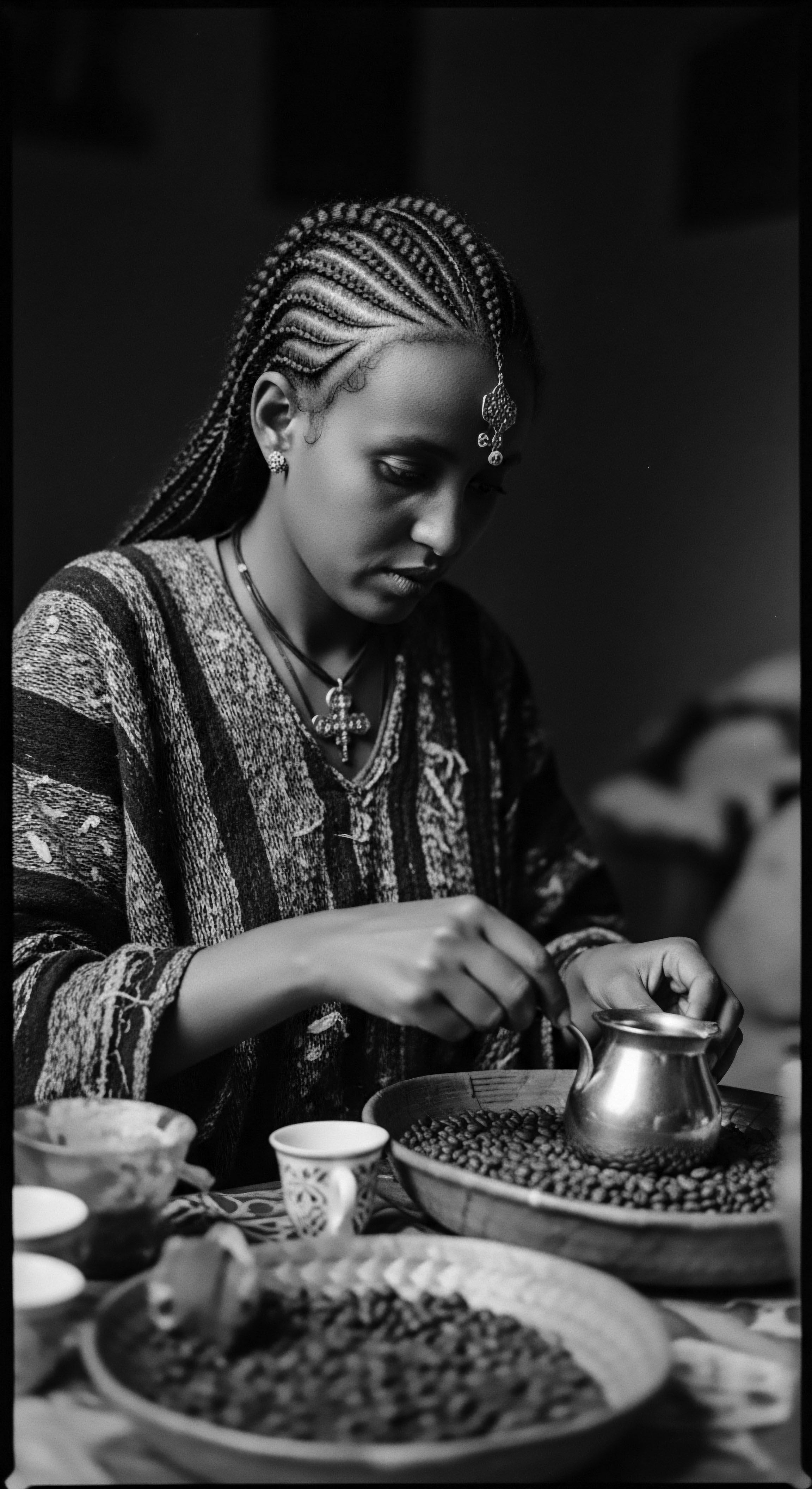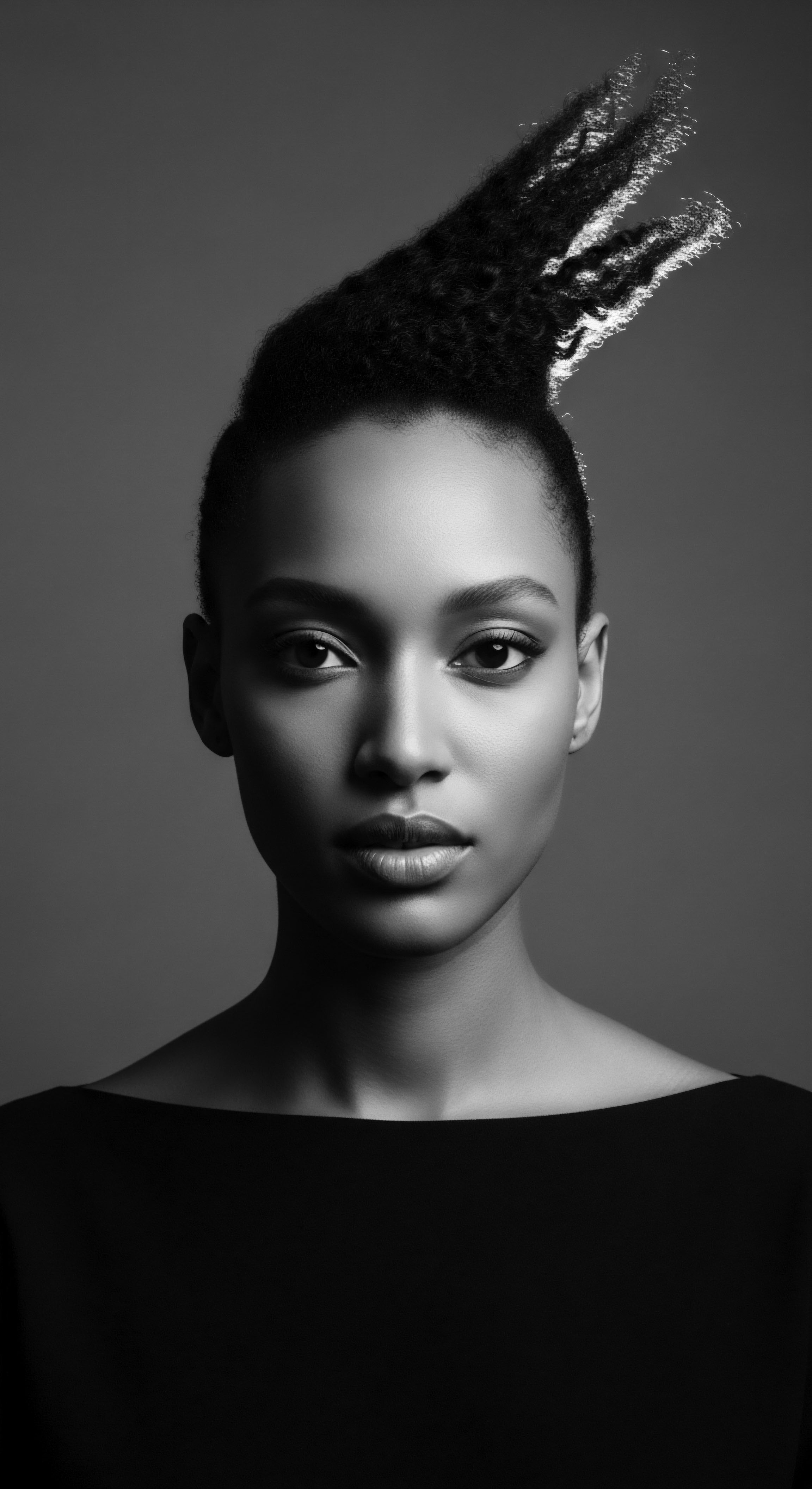
Roots
The very notion of what constitutes a strand of textured hair, whether it be tightly coiled, softly waved, or majestically kinky, carries within its structure an ancient story. This story begins not with a product on a shelf, but with the earth itself, with the ancestral lands, and with the dietary rhythms that sustained communities for generations. Can traditional eating patterns truly inform modern textured hair care?
To consider this question is to embark on a journey that travels beyond superficial beauty, reaching into the biological bedrock of who we are and the profound wisdom passed down through lineage. It is to recognize that hair, in its deepest sense, is a living record of our past, a testament to the nourishment received, both from the soil and from the spirit.

Hair Anatomy and Ancient Sustenance
The core of every hair fiber, the keratin, a protein of remarkable strength and resilience, relies on a steady supply of building blocks from within the body. What our ancestors consumed directly impacted this very foundation. Consider the diets prevalent across various ancestral lands, particularly those of African and diasporic communities. These diets were often rich in unprocessed, whole foods, deeply connected to the land’s bounty.
The consumption of lean proteins, a staple in many traditional African diets, provided the essential amino acids for keratin synthesis. For instance, ancestral diets often included a diverse array of legumes, grains, and tubers, alongside wild-caught fish or lean game, contributing to a robust internal environment for hair growth and health. (Haneke and Baran, 2011).
The strength of a single strand often mirrors the integrity of a community’s historical diet.
Beyond protein, the vitality of textured hair is also deeply tied to micronutrients. Vitamins and minerals, though needed in smaller quantities, perform a dance of intricate cellular functions that underpin hair follicle health. Vitamin A, vital for sebum production, ensuring the scalp is moisturized and hair is conditioned from the root, was readily available in foods like sweet potatoes and leafy greens that formed parts of traditional sustenance. B vitamins, particularly biotin, are known to support keratin production and hair growth.
Foods rich in these, such as eggs (where available and culturally accepted), whole grains, and leafy vegetables, were often part of diverse ancestral eating patterns. Iron, essential for oxygen transport to hair follicles, was supplied by greens and certain meats, while zinc, a mineral supporting hair tissue maintenance, could be found in seeds and legumes. These are not mere supplements but were organic components of daily sustenance, intimately tied to seasonal cycles and local ecosystems.

Understanding Textured Hair Lineage
The varied classifications of textured hair we use today, from coils to curls, carry a historical weight. While modern systems often categorize hair based on curl pattern, ancestral communities recognized and celebrated the unique characteristics of hair through a different lens—one tied to lineage, tribe, and spiritual significance. The very understanding of hair’s “type” was intrinsically linked to its historical and cultural context, often dictating care practices and adornment.
Modern science now offers a lens through which to comprehend the biological underpinnings of these diverse hair structures. The elliptical shape of the hair follicle in textured hair, the distribution of disulfide bonds within the keratin, and the unique challenges of moisture retention are all aspects that ancestral wisdom implicitly addressed through practices shaped by available resources and generations of observation. For example, the natural oils from traditional African plants, like shea butter and marula oil, were not just applied externally; their very presence in the ecosystem would have influenced broader dietary approaches, even if indirectly, by supporting the vitality of the communities that harvested them.

How do Ancestral Dietary Habits Relate to Hair Follicle Health Today?
Ancestral dietary habits provided a nutrient-dense foundation that directly supported the rapid cellular turnover of hair follicles. Hair is one of the fastest-growing tissues in the body, and its health is directly responsive to the nutritional landscape within. Traditional diets, often characterized by their unprocessed nature and reliance on local, seasonal produce, provided a constant stream of the necessary proteins, vitamins, and minerals.
- Protein ❉ Lean proteins from traditional food sources supplied amino acids, the building blocks for keratin, which forms the hair shaft.
- Vitamin A ❉ Found in orange and dark leafy vegetables, this nutrient supported sebum production for natural conditioning.
- B Vitamins ❉ Whole grains and certain legumes provided biotin and other B vitamins, vital for cellular metabolism in hair follicles.
- Iron ❉ Dark leafy greens and red meats, historically consumed, contributed iron for oxygen transport to hair cells.
This continuous internal nourishment ensured the hair follicle had the optimal conditions to produce strong, pliable strands. In contrast, modern diets often feature processed foods lacking these critical micronutrients, creating internal deficiencies that manifest as weakened, brittle hair or slowed growth. The wisdom of our ancestors, in consuming foods directly from the earth, offers a timeless blueprint for supporting our hair at its biological core.
| Traditional Food Group Root Vegetables (e.g. Sweet Potatoes, Yams) |
| Hair Nutrient Contribution Beta-carotene (Vitamin A), complex carbohydrates |
| Heritage Connection Staples in many African and diasporic diets, providing sustained energy for cell growth. |
| Traditional Food Group Leafy Greens (e.g. Collard Greens, Okra) |
| Hair Nutrient Contribution Iron, Vitamin C, Folate |
| Heritage Connection Widely cultivated and consumed, supporting blood circulation and collagen formation. |
| Traditional Food Group Legumes (e.g. Black-eyed Peas, Lentils) |
| Hair Nutrient Contribution Plant-based protein, zinc, biotin |
| Heritage Connection Key protein sources in plant-heavy diets, bolstering keratin structure and scalp health. |
| Traditional Food Group Nuts and Seeds (e.g. Pumpkin Seeds, Groundnuts) |
| Hair Nutrient Contribution Omega-3 fatty acids, zinc, Vitamin E |
| Heritage Connection Often used in traditional snacks and meals, contributing to scalp moisture and cell protection. |
| Traditional Food Group Understanding these dietary legacies reveals how internal nourishment has always shaped the external expression of hair. |

Ritual
The daily acts of caring for textured hair, from cleansing to conditioning and styling, are not just practical routines; they are echoes of ancient rituals, tenderly preserved and passed across generations. These rituals, often communal in nature, were deeply connected to the holistic well-being of the individual, where internal nourishment was considered inseparable from external presentation. Can traditional eating patterns truly inform modern textured hair care in the realm of styling and technique? The answer rests in understanding the profound interplay between the vitality of the body and the artistry of hair adornment, a relationship steeped in heritage.

Ancestral Styling and Internal Vitality
In many African cultures, intricate hairstyles signified social status, marital standing, age, and tribal affiliation. Creating these elaborate styles required hair that was not only structurally sound but also pliable and strong—qualities nurtured by the nutritional landscape within the body. Traditional eating patterns, which prioritized foods that supported healthy hair growth, inadvertently laid the foundation for the complex braids, twists, and coils that defined communal identity. A diet abundant in the vitamins and minerals needed for keratin production meant hair less prone to breakage, more elastic, and better able to hold these forms.
Hair rituals of old were often a celebration of health cultivated from within.
Beyond the physical capacity, there was a spiritual and communal element. Hair was a conduit to the divine, a symbol of wisdom and strength. The shared experience of hair braiding, often occurring under a shade tree or within family compounds, fostered bonds and transmitted ancestral knowledge. This communal act was not merely about aesthetics; it was about preserving identity, teaching younger generations the significance of their heritage, and maintaining the physical health of their hair through practices that were intrinsically linked to a nourishing internal environment.

Herbal Infusions and Dietary Parallels
The external application of herbal infusions and natural oils was, and remains, a cornerstone of traditional hair care across the diaspora. Many of these ingredients, derived from plants that also featured in the local diet, speak to an intuitive understanding of nature’s offerings for both internal and external health. For instance, the use of Moringa oil for hair health mirrors the consumption of Moringa leaves for their nutritional density.
This tree, often called the “miracle tree,” is rich in vitamins A, C, and B, along with minerals like iron and zinc—all essential for hair growth and scalp health. The wisdom of incorporating Moringa, both in meals and in hair preparations, highlights a holistic approach where the lines between food and topical remedy blurred.
Another powerful example hails from the Basara Arab women of Chad, renowned for their traditional hair care practices that foster extraordinary hair length. Their ritual involves the use of Chebe powder , a concoction of local herbs and seeds. While Chebe is applied topically to coat and protect the hair strands, the underlying philosophy of length retention and strength aligns with a body that is internally nourished.
The traditional consumption of nutrient-rich foods within the Chadian region would certainly support the hair’s capacity to withstand the environmental factors and daily styling that Chebe helps mitigate. The strength that allows for such length, while externally supported, finds its ultimate biological foundation in a body well-sustained by indigenous eating patterns.

How can Traditional Hair Care Tools Reflect Ancestral Dietary Habits?
Traditional hair care tools, though seemingly simple, often reflect a deeper ancestral connection to food resources and the wisdom derived from them. Consider the various combs carved from local woods, or the use of gourds as vessels for mixing herbal rinses or applying oils. The very materials used for these tools were often sourced from the same natural environments that provided sustenance. The smooth surfaces of polished wood or horn, used for detangling and smoothing, would work harmoniously with hair conditioned by natural oils and strengthened by a balanced diet.
The longevity of these natural tools, unlike many modern plastic counterparts, speaks to a respect for materials and a sustainable approach to resource utilization, echoing the sustainable harvesting and consumption of food. The process of preparing traditional hair applications—like grinding seeds for oils or infusing herbs—often employed similar methods to food preparation, forging a seamless link between kitchen and beauty ritual.
- Combs from Natural Materials ❉ Carved from local hardwoods or animal horn, they imply a gentle approach to hair, complementing hair made strong by internal nutrition.
- Gourds and Bowls ❉ Used for mixing topical remedies, these vessels mirror their use in food preparation and serving, linking hair care to culinary traditions.
- Ceremonial Headwraps ❉ While a stylistic adornment, their use often protected hair nurtured by traditional diets, preserving styles and preventing breakage.

Relay
The relay of ancestral wisdom from one generation to the next is a continuum, not a static preservation. Modern textured hair care, in its most profound manifestation, is not a departure from the past, but a living extension of it. The inquiry into whether traditional eating patterns can inform contemporary routines moves beyond historical anecdote into practical application, revealing how the foundational strength cultivated through diet centuries ago still holds resonance today. The essence of this relay lies in recognizing the interconnectedness of internal health and external vitality, especially for hair that carries the rich legacy of textured heritage.

Building Personalized Regimens ❉ Lessons from Ancestral Wellness
Crafting a textured hair regimen that truly thrives means understanding the specific needs of the hair, much as ancestral communities understood the specific needs of their bodies relative to their environment. Traditional wellness philosophies often viewed the body as a whole, where each part contributed to the overall harmony. This holistic perspective, deeply rooted in the knowledge of local flora and fauna, naturally extended to hair health.
For instance, the emphasis on nutrient-dense, unprocessed foods in many traditional African diets directly correlates with the strong, pliable hair observed in those communities. These dietary patterns, often high in plant-based proteins, healthy fats, and a spectrum of vitamins and minerals, laid the groundwork for robust hair growth cycles. The practice of traditional hair oiling, as seen with various cultures across the diaspora, was not merely an external act; it complemented the internal nourishment, creating a comprehensive system of care.
Consider the broader implications for modern routines. If a traditional diet provided sufficient protein for keratin production, then a contemporary regimen should assess protein intake, recognizing that chemically processed foods often lack this fundamental building block. If ancestral practices included indigenous oils for scalp health, then modern choices should include similar botanical ingredients that mimic those beneficial properties. This is a purposeful alignment, where the scientific understanding of hair biology meets the wisdom of ancestral observation.

How can Understanding Ancestral Food Preparation Methods Influence Modern Ingredient Choices?
Understanding how ancestral communities prepared their food offers deep insights into the bioavailability of nutrients, which directly impacts hair health. Fermentation, soaking, and slow cooking, common across many traditional eating patterns, enhanced nutrient absorption, making vitamins, minerals, and proteins more accessible to the body’s systems, including hair follicles. When choosing modern hair care ingredients, drawing from this wisdom suggests prioritizing compounds in forms easily assimilated by the scalp and hair, often mirroring these ancient preparations.
For example, cold-pressed oils preserve delicate nutrients, similar to how ancestral methods carefully extracted oils from seeds. Similarly, ingredients derived from whole plants, rather than highly refined extracts, carry a more complete spectrum of beneficial compounds, a reflection of traditional reverence for the unadulterated gifts of nature.

The Nighttime Sanctuary ❉ Bonnet Wisdom and Its Historical Threads
The ritual of protecting textured hair at night, often with a satin bonnet or silk scarf , holds a history that spans continents and centuries. This modern practice, essential for preserving moisture and preventing friction-induced breakage, echoes the ancestral use of headwraps and coverings. Historically, headwraps in African cultures were not solely for adornment; they served practical purposes of protection from the elements, as well as holding deep symbolic meaning connected to identity, status, and resistance.
The materials used for these historical coverings, often natural fibers, offered a protective layer, much like modern silk or satin helps to reduce stress on hair strands. The connection to traditional eating patterns here is indirect yet profound ❉ a diet that nourished the hair to be strong and resilient would allow it to better withstand the daily manipulations and environmental exposures, making the protective nighttime ritual even more effective in preserving length and health. The durability and health of the hair itself, supported by internal nourishment, made these external protective measures truly impactful.
Ancestral knowledge of the earth’s bounty informs both internal sustenance and external hair adornment.

Case Study ❉ Moringa and Hair Vitality in the African Diaspora
A compelling example of traditional eating patterns informing modern hair care comes from the continued reverence for Moringa oleifera . Native to parts of Africa and Asia, this “miracle tree” has been a staple in traditional diets for centuries, celebrated for its medicinal properties and nutritional density. The leaves are consumed for their vitamins (A, C, B), minerals (iron, potassium, magnesium, zinc), and protein content, all of which directly support overall health, including the health of hair.
Beyond dietary consumption, Moringa oil, extracted from the seeds, has been traditionally used topically for skin and hair conditioning. Modern scientific studies are beginning to validate this ancestral wisdom. Research indicates that the rich antioxidant profile of Moringa, including quercetin and chlorogenic acid, helps protect the scalp and hair from oxidative stress, a factor contributing to hair loss. Its vitamin B content promotes red blood cell production, enhancing oxygen and nutrient delivery to hair follicles, while its zinc content supports healthy oil glands and prevents dryness.
The continued presence of Moringa in traditional diets across regions of the African diaspora provides a lived example of how internal nourishment directly contributes to hair vitality that can then be further supported by topical applications. This is not a historical relic; it is a vibrant, living practice. The women who have traditionally consumed Moringa in their diets, and used its oil on their hair, exemplify the direct correlation between a nutrient-rich eating pattern and resilient, healthy textured hair, a connection now being further explored and validated by contemporary science. This integration of dietary tradition and topical use offers a clear pathway for modern textured hair care to look to the ancestral plate for foundational wisdom.
| Traditional Ingredient (Dietary Role) Avocado (Healthy Fats, Vitamins E, B) |
| Modern Hair Care Application Hair masks, conditioning treatments |
| Shared Benefits for Hair Heritage Moisture, scalp health, antioxidants for strand protection. |
| Traditional Ingredient (Dietary Role) Coconut Oil (Healthy Fats, Lauric Acid) |
| Modern Hair Care Application Pre-poo treatments, moisturizers, sealants |
| Shared Benefits for Hair Heritage Deep conditioning, protein retention, anti-microbial scalp benefits. |
| Traditional Ingredient (Dietary Role) Shea Butter (Fatty Acids, Vitamins A, E) |
| Modern Hair Care Application Styling creams, deep conditioners, scalp balms |
| Shared Benefits for Hair Heritage Emollient, protective barrier, anti-inflammatory for scalp. |
| Traditional Ingredient (Dietary Role) Moringa (Vitamins, Minerals, Protein) |
| Modern Hair Care Application Hair oils, scalp treatments, supplements |
| Shared Benefits for Hair Heritage Nutrient supply for growth, antioxidant protection, strengthening. |
| Traditional Ingredient (Dietary Role) Many foods valued in ancestral diets also provide potent benefits when applied directly to textured hair, offering a holistic care approach. |
The understanding of nutritional deficiencies and their impact on hair growth is well-documented in modern research. Lack of essential nutrients such as iron, zinc, biotin, and various vitamins (A, C, D, E) can contribute to hair loss or slowed growth. Traditional eating patterns, by their very nature of being whole-food centric and diverse, often provided these crucial elements in abundance. This offers a powerful lesson ❉ cultivating an internal landscape rich in nutrients through a mindful diet can significantly support the external resilience and beauty of textured hair, honoring a legacy where health from within was the ultimate beauty secret.
- Dietary Proteins ❉ Consuming foods like eggs, fish, and lean meats, or plant-based options such as lentils and beans, supplies the amino acids necessary for keratin formation, enhancing hair strength and integrity.
- Essential Fatty Acids ❉ Sources like avocados, nuts, and certain fish provide omega-3s, which contribute to scalp hydration and overall hair sheen, preventing dryness and brittleness.
- Vitamins and Minerals ❉ A diet rich in spinach, sweet potatoes, and berries delivers vitamins A, C, and E, alongside minerals like zinc and iron, all of which are vital for healthy hair follicle function and antioxidant defense.

Reflection
The journey through the question of whether traditional eating patterns can inform modern textured hair care concludes not with a final answer, but with an open invitation. It is an invitation to rediscover a profound connection, one that threads through generations of Black and mixed-race experiences, anchoring contemporary care in the deep well of ancestral wisdom. The “Soul of a Strand” is not merely a poetic ideal; it is a living truth, reflecting the enduring legacy of nourishment—both physical and spiritual—that has always sustained our hair and our spirits.
Our hair, in its glorious coils and intricate patterns, carries the memory of resilience, adaptation, and an innate understanding of its needs. This understanding was historically shaped by the earth’s yield, by hands that cultivated, prepared, and consumed foods imbued with life-giving properties. The vibrant health of hair observed in ancestral communities was not a mere stroke of luck, but a direct manifestation of dietary harmony—a testament to the balanced intake of proteins, vital minerals, and hydrating components found in their natural environments.
As we navigate the modern world of hair care, the ancestral table offers more than just historical curiosity; it offers a foundational blueprint. It reminds us that external treatments, however sophisticated, find their truest efficacy when paired with internal nourishment. The powerful legacy of our forebears compels us to listen to the whispers of tradition, to seek out ingredients that echo the natural bounty of our heritage, and to recognize that true radiance springs from a deeply rooted sense of well-being. This ongoing dialogue between ancient practice and contemporary understanding enriches our routines, grounds our choices, and ensures that the story of textured hair continues to be one of strength, beauty, and unwavering connection to its luminous past.

References
- Haneke, E. and Baran, R. (2011). Hair and Nails. In ❉ Dermatology in General Medicine. McGraw-Hill Education.
- Rushton, D. H. (2002). Nutritional factors and hair loss. Clinical and Experimental Dermatology, 27(5), 396-404.
- Almohanna, H. M. et al. (2019). The Role of Vitamins and Minerals in Hair Loss ❉ A Review. Dermatology and Therapy, 9(1), 51-70.
- Finner, A. M. (2013). Nutrition and hair loss. Clinical Dermatology, 31(1), 1-6.
- Davis, M. G. & Kallam, J. A. (2020). Hair Loss in Women ❉ A Review of the Current Literature. Journal of Clinical and Aesthetic Dermatology, 13(2), 22-29.
- Giacomoni, P. U. & Maibach, H. I. (Eds.). (2018). Hair and Hair Diseases. Springer.
- Cashin, T. (2007). The Hair Story ❉ Untangling the Roots of Black Hair in America. St. Martin’s Press.
- Byrd, A. & Tharps, L. D. (2014). Hair Story ❉ Untangling the Roots of Black Hair in America. St. Martin’s Press.
- Robbins, C. R. (2012). Chemical and Physical Behavior of Human Hair. Springer.
- Abbas, K. M. et al. (2017). African Ethnobotany ❉ Traditional and Complementary Medicines. Springer.
